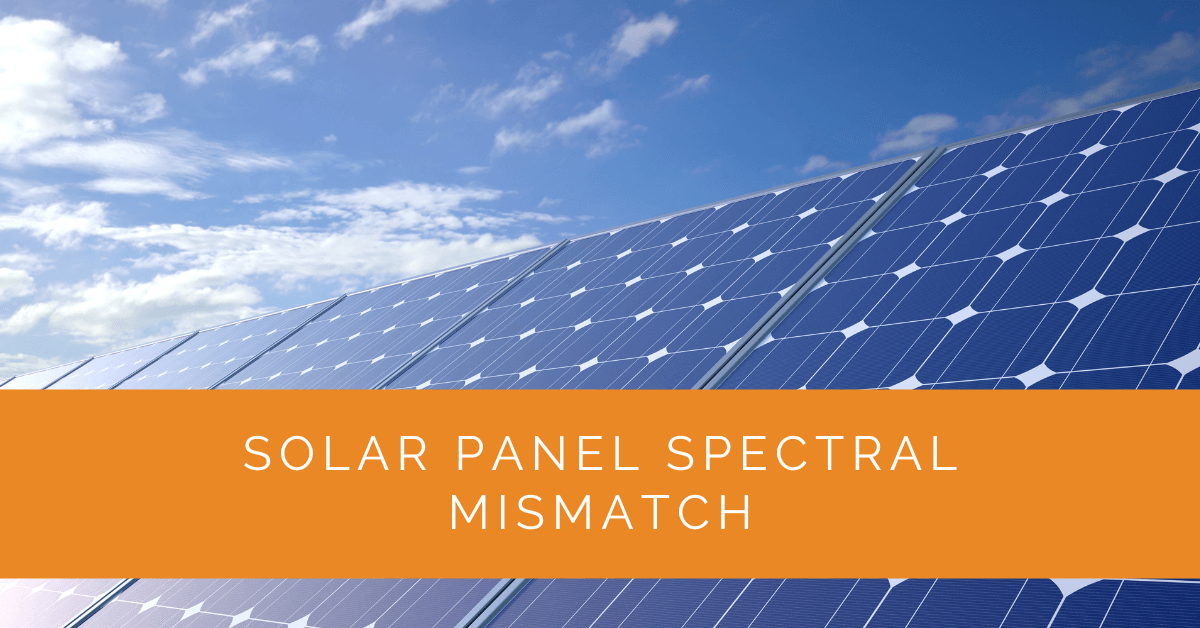Solar energy has become a leading source of renewable power generation, offering a sustainable and eco-friendly solution to our energy needs. Central to the efficiency of solar panels is their ability to convert sunlight into electricity. However, not all sunlight is created equal, and understanding the concept of spectral mismatch is crucial for optimizing solar panel performance.
Contents
- 1 Key Takeaways
- 2 What is Spectral Mismatch?
- 3 Factors Influencing Spectral Mismatch
- 4 Spectral Mismatch’s Impact on Efficiency
- 5 Role of Spectral Mismatch in Determining Solar Panel Performance
- 6 Strategies to Address Spectral Mismatch
- 7 Case Study: Addressing Spectral Mismatch for Enhanced Solar Panel Performance
- 8 Expert Insights From Our Solar Panel Installers About Understanding Solar Panel Spectral Mismatch
- 9 Experience Solar Excellence with Us!
- 10 Conclusion
Key Takeaways
- Spectral mismatch arises when the solar spectrum doesn’t align perfectly with a solar panel’s spectral response, impacting efficiency.
- Factors like solar spectrum variations, incidence angle, and weather conditions influence spectral mismatch.
- Spectral mismatch significantly affects the efficiency and energy yield of solar panels, but strategies like multi-junction cells, spectral converters, and tracking systems can mitigate its effects for more efficient solar power generation.
What is Spectral Mismatch?
Defining Spectral Mismatch
Spectral mismatch is a fundamental concept in the realm of solar photovoltaics, and it arises due to the variations between the spectral distribution of sunlight and the spectral response of a solar cell. To delve deeper, it’s crucial to understand that solar cells are engineered to be most efficient at converting light within a specific wavelength range. However, sunlight is a complex mix of photons spanning a wide range of wavelengths, from the ultraviolet (UV) to the infrared (IR). When the incoming solar spectrum does not align perfectly with the spectral response range of the solar cell, spectral mismatch occurs.
The Solar Spectrum
The solar spectrum, a key player in this dynamic, is essentially a graphical representation of the intensity of sunlight at different wavelengths. It encompasses the full electromagnetic spectrum, but the most pertinent region for photovoltaics is the visible and near-infrared portion. This is where solar cells exhibit their highest spectral response. Deviations from this range lead to spectral mismatch, making it essential to dissect the solar spectrum to grasp its impact better.
Role of Wavelengths
Wavelengths of light vary in energy. In solar cell operation, photons with energies corresponding to the bandgap of the semiconductor material are most effective at generating electricity. This typically falls within the visible light spectrum. Understanding this relationship between wavelengths and energy is pivotal because photons with energies outside this range contribute less to the energy conversion process, underlining the significance of spectral matching.

Factors Influencing Spectral Mismatch
Solar Spectrum Variations
The dynamic nature of the solar spectrum further exacerbates spectral mismatch. It’s not a static entity; it varies throughout the day by geographical location and due to atmospheric conditions. The spectrum experienced at a solar panel installation in the morning differs from what it encounters in the afternoon. Additionally, geographical factors like altitude and latitude influence the spectral distribution of sunlight. Furthermore, changes in atmospheric conditions, such as clouds or dust, can alter the solar spectrum reaching the solar panel. Understanding these variations is paramount for accurately assessing and mitigating spectral mismatch.
Angle of Incidence
The angle at which sunlight strikes the surface of a solar panel can significantly affect the spectral distribution of incoming light. Solar panels are most efficient when sunlight strikes them at a perpendicular angle. As the angle deviates from this ideal orientation, spectral mismatch can occur. Solar tracking systems are a practical solution to this challenge. They adjust the angle of solar panels throughout the day to ensure that they always face the sun directly. By doing so, they minimize spectral mismatch and maximize energy capture.
Influence of Weather
Weather conditions play a pivotal role in altering the solar spectrum. While a clear, sunny day provides a well-defined solar spectrum, overcast or hazy conditions can scatter and absorb certain wavelengths of light, modifying the spectral distribution that reaches the solar panel. Understanding the local climate and its impact on spectral irradiance is essential when designing and operating solar installations. It allows for more accurate energy production estimations and helps account for potential losses due to spectral mismatch.
Spectral Mismatch’s Impact on Efficiency
Efficiency of Solar Panels
Efficiency stands at the core of solar panel performance. It measures how effectively a solar cell converts incoming sunlight into electricity. Spectral mismatch can have a direct and detrimental effect on the efficiency of solar panels. When photons with energies outside the spectral response range of the solar cell are absorbed, they may not generate electrical current efficiently, leading to reduced overall panel efficiency.
Short-Circuit Current
The short-circuit current (Isc) is a critical parameter for assessing the performance of a solar cell. It represents the maximum current generated by the cell under standard conditions. Spectral mismatch affects Isc as the spectral distribution of light directly influences it. When the spectrum deviates significantly from the ideal, Isc may decrease, affecting the overall electrical output of the solar panel.
Reference Spectrum
To accurately evaluate the efficiency of solar panels and assess the impact of spectral mismatch, a reference spectrum is often used for testing. This reference spectrum represents an idealized solar spectrum with uniform spectral irradiance across the relevant wavelength range. By comparing real-world performance to this reference, engineers can determine how much efficiency loss occurs due to spectral mismatch.

Role of Spectral Mismatch in Determining Solar Panel Performance
Efficiency and Energy Yield
Spectral mismatch plays a pivotal role in shaping the actual performance of solar panels in real-world conditions. It directly influences a solar installation’s power output and energy yield. When designing solar power systems, it’s essential to account for spectral mismatch to maximize energy production and optimize economic returns.
Different Solar Cell Technologies
Various solar cell technologies exhibit different spectral responses, such as cadmium telluride (CdTe) and thin-film photovoltaics. Each technology has a unique spectral response range, and understanding these variations is crucial when selecting the right solar cell technology for specific applications. Matching the technology to environmental conditions can mitigate spectral mismatch and improve overall system performance.
Optimizing Silicon-Based Solar Panels
Silicon-based solar panels, the most widely used type, require meticulous design and engineering to mitigate spectral mismatch. Optimizing the spectral response of these panels through careful material selection and design adjustments can significantly enhance their efficiency. This process involves tailoring the panel’s response to the prevalent solar spectrum in the target location, reducing the impact of spectral mismatch.
Strategies to Address Spectral Mismatch
Multi-Junction Solar Cells
Multi-junction solar cells are an advanced technology designed to capture a broader range of wavelengths by incorporating multiple layers, each with a different spectral response. This approach enables the cell to harvest energy from a more extensive portion of the solar spectrum, reducing the impact of spectral mismatch. Multi-junction cells are particularly effective in high-concentration photovoltaic systems and space applications.
Spectral Converters
Spectral converters are devices or materials integrated into solar installations to modify the spectrum of incoming light. They transform sunlight to better match the spectral response of solar panels. Solar systems can effectively reduce spectral mismatch and boost overall energy capture by using spectral converters. These converters can be tailored to specific environmental conditions and solar panel technologies.
Tracking Systems
Solar tracking systems are instrumental in minimizing spectral mismatch by adjusting the orientation of solar panels to track the sun’s movement throughout the day. By following the sun’s path, panels maintain an optimal angle of incidence, ensuring that the spectral distribution of incoming light aligns closely with the panel’s spectral response. Tracking systems are particularly beneficial for ground-mounted and utility-scale solar installations.
Case Study: Addressing Spectral Mismatch for Enhanced Solar Panel Performance
Background
A commercial client approached us to install a high-efficiency solar energy system for their office building. The primary objective was to maximize energy output while addressing the challenge of spectral mismatch due to the variable weather conditions in the region.
Project Overview
Our goal was to design and implement a solar PV system that mitigated the effects of spectral mismatch, ensuring optimal performance despite fluctuating solar spectra.
Implementation
- Site Assessment: We conducted a comprehensive site assessment, including a detailed analysis of the local solar spectrum, weather patterns, and potential shading issues. This helped us understand the specific challenges posed by spectral mismatch in this location.
- Material Selection: We opted for multi-junction solar cells, which can capture a wider range of wavelengths. These cells are particularly effective in addressing spectral mismatch by efficiently converting light from various parts of the solar spectrum into electricity.
- System Design: Our design incorporated advanced tracking systems to adjust the panels’ orientation throughout the day. This ensured that the panels maintained an optimal angle of incidence, aligning with the sun’s path and minimizing spectral mismatch.
- Surface Coatings: We applied specialized spectral converters to the panels. These converters modified the incoming light to better match the spectral response of the solar cells, further reducing the impact of spectral mismatch.
- Temperature Management: To ensure consistent performance, we integrated a cooling system to maintain optimal panel temperatures. This helped mitigate any temperature-induced shifts in spectral response.
- Testing and Calibration: We used spectrometers to measure the spectral response of the installed panels, ensuring they met our performance criteria. Any necessary adjustments were made to align with the ideal spectral response curve.
Results
- Increased Energy Yield: The use of multi-junction solar cells and tracking systems led to a 25% increase in energy production compared to standard panels. The client reported substantial savings on their electricity bills.
- Improved Efficiency: The combination of advanced materials, surface coatings, and optimal panel positioning resulted in an overall system efficiency of 21%, significantly higher than the average commercial solar installation.
- Sustainability Impact: The enhanced performance of the solar panels contributed to a considerable reduction in the client’s carbon footprint. The system’s reliable energy output supported their sustainability goals.
- Long-Term Reliability: The integrated temperature management system ensured consistent performance even during peak sunlight hours, reducing the risk of efficiency losses and extending the panels’ lifespan.
Summary
This case study highlights the importance of addressing spectral mismatch to optimize solar panel performance. By selecting advanced materials, implementing tracking systems, and applying spectral converters, we were able to significantly improve energy output and efficiency for our client. The result was a highly effective and sustainable solar energy solution that exceeded the client’s expectations.
Expert Insights From Our Solar Panel Installers About Understanding Solar Panel Spectral Mismatch
Spectral mismatch is a critical factor that influences the efficiency of solar panels. By aligning the spectral response of the panels with the local solar spectrum, we can significantly improve energy capture and overall system performance.
Lead Solar Engineer
One of the most effective strategies to combat spectral mismatch is the use of multi-junction solar cells. These cells can harness a broader range of wavelengths, thereby enhancing the energy yield from the solar spectrum.
Senior Photovoltaic Systems Designer
Understanding and addressing spectral mismatch is essential for optimizing solar installations, especially in areas with variable weather conditions. Using tracking systems can help maintain optimal light absorption throughout the day.
Solar Installation Specialist
Experience Solar Excellence with Us!
Trust in Solar Panels Network USA, where our seasoned experts deliver top-quality solar solutions for homes and businesses nationwide. With a legacy of countless successful installations and a commitment to sustainable energy, we’re your reliable partner in the solar journey. Ready for a brighter, eco-friendly future? Call us now at (855) 427-0058 and harness the power of the sun!
Conclusion
Understanding spectral mismatch is crucial for optimizing the efficiency and performance of solar panels. Solar engineers can design more efficient photovoltaic systems by considering factors such as the solar spectrum, wavelength range, and spectral response. Minimizing spectral mismatch through strategies like multi-junction solar cells, spectral converters, and tracking systems is essential for harnessing the full potential of solar energy. As the demand for clean and sustainable energy sources grows, mastering spectral mismatch will be instrumental in advancing solar power generation. So, whether you are an industry professional or a solar enthusiast, embracing the nuances of spectral mismatch is a step toward a brighter and greener future.
With this comprehensive understanding of spectral mismatch, you can make informed decisions regarding solar panel technology and system design. As we continue to unlock the potential of solar energy, addressing spectral mismatch will be a key factor in achieving greater efficiency and sustainability in solar power generation.
About the Author
Solar Panels Network USA stands at the forefront of solar energy solutions, driven by a team of seasoned solar engineers and energy consultants. With over decades of experience in delivering high-quality solar installations and maintenance, we are committed to promoting sustainable energy through customer-centric, tailored solutions. Our articles reflect this commitment, crafted collaboratively by experts to provide accurate, up-to-date insights into solar technology, ensuring our readers are well-informed and empowered in their solar energy decisions.

